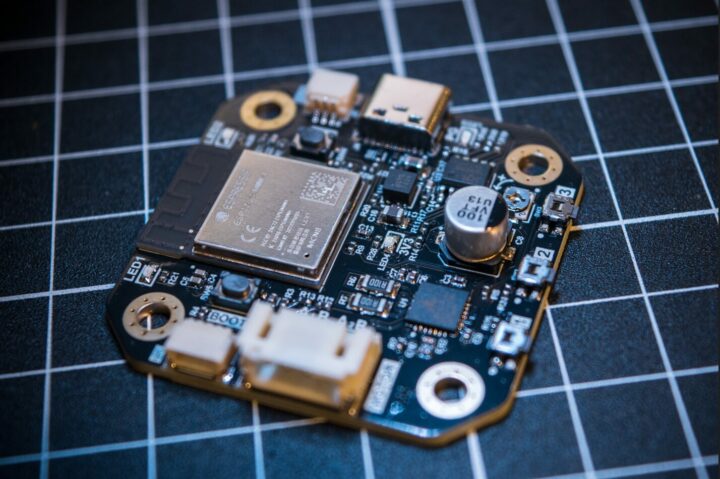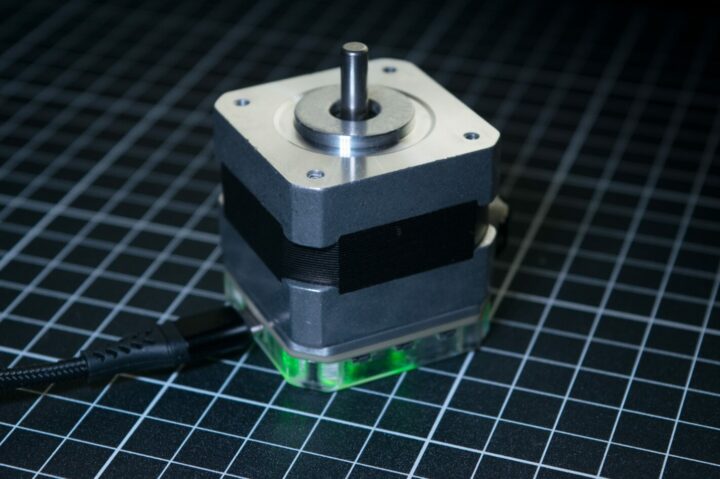The PD Stepper is a NEMA 17 integrated stepper motor driver and controller board powered by USB power delivery that combines an ESP32-S3 wireless microcontroller, the Trinamic TMC2209 ultra-silent motor driver, and other components onto a single board for Smart Home and automation applications.
The maker, Josh R., states that the PD Stepper isn’t another “just because we can” project. It addresses the need for an integrated motor driver and controller module that can used in compact or space-constrained designs.
The ESP32-S3 SoC controls the other components on the board and provides wireless connectivity as well as access to development tools and libraries such as ESPHome and ESP-Now. The motor driver IC, Analog Devices’s Trinamic TMC2209, offers efficient, noiseless control of two-phase stepper motors. Other onboard components and connectors include an AS5600 magnetic rotary position sensor, a 3.3V buck converter, a Qwiic/Stemma QT connector, a motor connector, and an AUX connector that can send/accept I2C, serial UART, and other signals.
The USB-C connector on the board supports Power Delivery and can supply up to 50W of power to a connected stepper motor via the TMC2209 driver.
Wi-Fi (e.g. ESPHome, ESP-NOW, or through a web server) is the main way to control the PD Stepper, but it can also be controlled via the aux connector, I2C, UART, or BLE. Multiple PD Steppers can be daisy-chained together and controlled with sensors.
PD Stepper specifications:
- SoC – ESP32-S3 microcontroller, dual-core Tensilica LX7 @ up to 240 MHz; 512KB SRAM; 2.4GHz Wi-Fi and BLE
- Motor control
- Analog Devices TMC2209 stepper motor driver
- Voltage Range – 4.75V to 29V DC
- STEP/DIR and UART interface
- Up to 50W of power to drive a stepper motor
- AMS AS5600 magnetic rotary encoder
- Analog Devices TMC2209 stepper motor driver
- Expansion – Qwiic/Stemma QT JST SH connector, JST PH 4-pin motor connector, AUX
- Misc – 3x buttons, 4x LEDs (2 programmable), motor temperature sensor
- Power
- 5V, 9V, 12V, 15V, or 20V via USB Power Delivery (software and hardware selectable)
- Onboard 3.3V buck converter
- Form Factor – Mounts to standard NEMA 17 stepper motors
Possible applications/use cases include home automation with ESPHome and Home Assistant, closed-loop control with STEP/DIR inputs, wireless position copying from the encoder to another motor, and a camera slider with a web interface for control and sensorless homing. Similar devices we have taken a look at include the FOCn driver module, ODrive Micro, and the SwarmDrive board,
The PD Stepper integrated motor driver and controller is completely open-source, with schematics, Gerber files, and 3D files publicly available in the GitHub repository. The software is still a work in progress but you can find ESPHome config files and Arduino sample code in the same repository.
It is currently available for pre-order at $61 for the full kit and $48 for the partial kit. The partial kit features the PD Stepper board, mounting hardware, motor wires, an encoder magnet, and a small heatsink while the full kit adds polycarbonate housing, an aluminum heat spreader, and a larger heatsink. Orders are expected to ship from October 2024.
Via Hackster.io

Tomisin is a writer specializing in hardware product reviews, comparisons, and explainers. He is very passionate about small form factor and single-board computers.
Support CNX Software! Donate via cryptocurrencies, become a Patron on Patreon, or purchase goods on Amazon or Aliexpress








This is an interesting device but once again the pricing is out of line with what you are getting in my opinion, but I understand it’s not being mass produced and the price could be lower at scale.
Niche is pay to play.
Btw, Infineon is promoting USB C PD powered brushless motors using their EZ-PD PMG1-S3 chipset. I’ve seen Infineon ads for this several times on Instagram.
Here is a link to a blog about this:
https://community.infineon.com/t5/Blogs/Building-a-USB-PD-BLDC-brushless-motor-controller/ba-p/457794#.
The EZ-PD PMG1-S3 is impressive and it is capable of 150 watts. Wonder when/if we will see closed loop boards and steppers for 3D printers using these?
I want to see what happens if you configure the steppers for wifi mirroring and then install them into two different 3d printers 😂
Wonder if such tiny stepper motors could be in solar panel movement. Or can they be and what advantages would be? Making the whole panel lighter and dematerialized is a definite win.